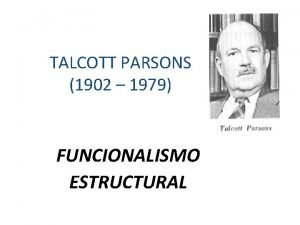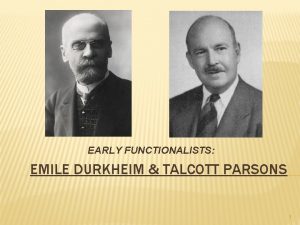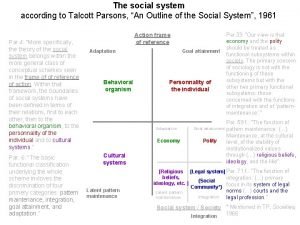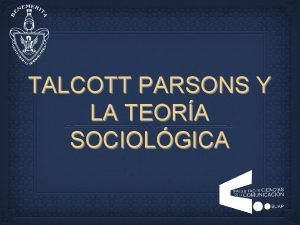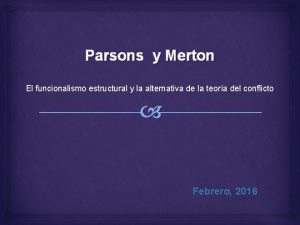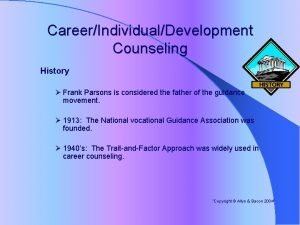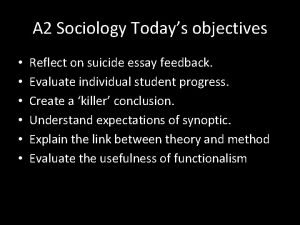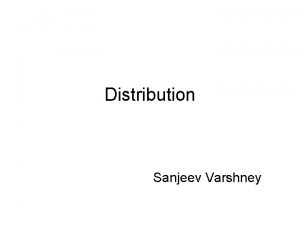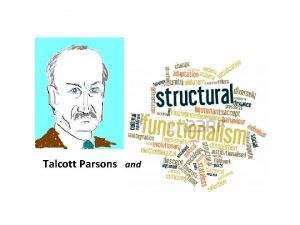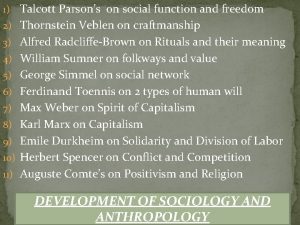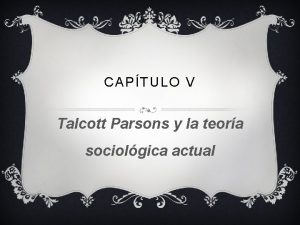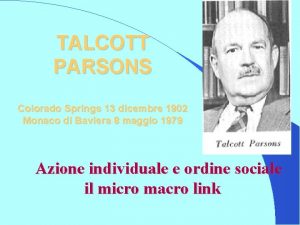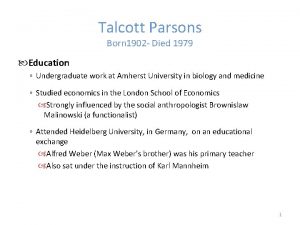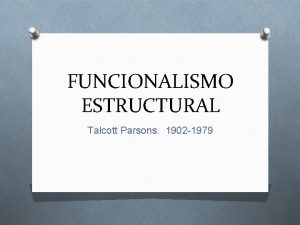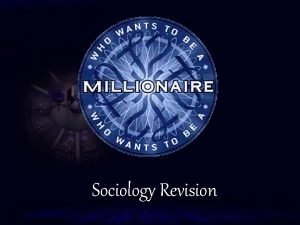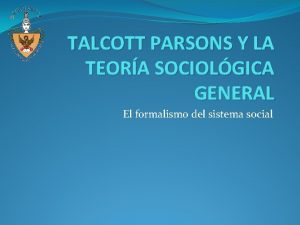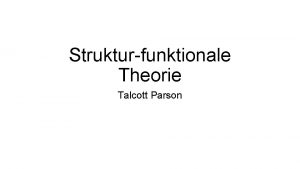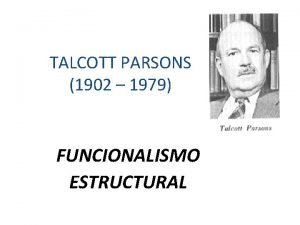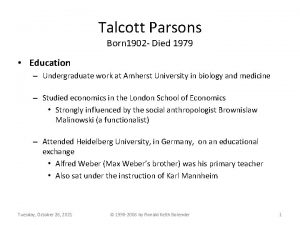Talcott Parsons and FUNCTIONALISMS PRECURSORS in various ways





























































- Slides: 61

Talcott Parsons and

FUNCTIONALISM’S PRECURSORS (in various ways) Comte, Spencer, Durkheim, Malinowski, Gilman FUNCTIONALISM THEMES Organic Analogy “Evolutionary” Change – Complexity, Adaptability Systems, Sub-Systems Structural Arrangements Structural Differentiation Specialization Integration System Equilibrium Nested Systems Coordination and Control Steering

Talcott Parsons Born 1902 - Died 1979 Education: • Undergraduate work at Amherst University in biology and medicine • Studied economics in the London School of Economics • Strongly influenced by the social anthropologist Brownislaw Malinowski (a functionalist) • Attended Heidelberg University, in Germany, on an educational exchange • Alfred Weber (Max Weber’s brother) was his primary teacher • Also sat under the instruction of Karl Mannheim 3

Talcott Parsons Harvard Professor of Economics, and then Sociology, 1927 -1973 Founded the Department of Social Relations combining Sociology, Anthropology, and Psychology, 1944 Key works: The Structure of Social Action (1937) The Social System (1951) Social Structure and Personality (1964) The System of Modern Societies (1971) The Structure and Change of the Social System (1983) 4

Talcott Parsons a partial bibliography




Talcott Parsons and Grand Theory “The dominant figure in American sociology – if not world-wide – from the mid-1940’s to the mid-1970’s. ” (Bell, 1979) “Talcott Parsons was probably the most prominent theorist of this time, and it is unlikely that any one theoretical approach will so dominate sociological theory again. ” (Turner 1998) “Parsons’ theory of society is plagued by an absence of clarity. His work abounds with ambiguities in both semantics and syntax. ” (Perdue, 1986) 9

Talcott Parsons and Grand Theory

Talcott Parsons: The Social System



Talcott Parsons: The Structure of Social Action • Voluntaristic Theory of Action: the Unit Act – Involves these basic elements • Actors are individual persons • Actors are viewed as goal seeking • Actors possess alternative means to achieve their goals 14

Talcott Parsons: The Structure of Social Action • Actors are confronted with a variety of situational conditions, including their own biological makeup and heredity as well as various external ecological constraints, that influence the selection of goals and means. • Actors are governed by values, norms, and other ideas such that these ideas influence what is considered a goal and what means are selected to achieve it. • Action involves actors making subjective decisions about the means to achieve goals, constrained by these ideas, the situational conditions including the means available. 15


Talcott Parsons: The Structure of Social Action

Talcott Parsons: The Social System TYPES OF ACTION




W. I. Thomas and The Definition of The Situation

Talcott Parsons: The Social System How do social systems survive? More specifically, why do institutionalized patterns of interaction persist? 23

Talcott Parsons: The Social System THE PROCESS OF INSTITUTIONALIZATION

Talcott Parsons: The Social System CYBERNETIC HIERARCHY OF CONTROL


Talcott Parsons: The Social System

Talcott Parsons: The Social System The Four Functional Imperatives • Adaptation – Securing sufficient resources from the physical and social environment and then distributing these throughout the system. • Goal Attainment – Establishing priorities among system goals and mobilizing system resources for their attainment. 28

Talcott Parsons: The Social System The Four Functional Imperatives • Integration – Coordinating and maintaining viable interrelationships among system units thru communication and common value systems. 29

Talcott Parsons: The Social System The Four Functional Imperatives • Latency (Two related problems): • Pattern Maintenance – Ensuring that actors in the social system display the appropriate characteristics • Motives • Needs • Roles • Tension Management – dealing with the internal tensions and strains of actors as they meet the demands of the social system. 30

ACTION SYSTEMS within PARSONS’ AGIL MODEL ADAPTATION GOAL ATTAINMENT Economic: Energy for Environmental Interactions Political: Selective Group-Determination INTEGRATION LATENT PATTERN MAINTENANCE & TENSION MANAGEMENT Cultural-Legal System: Institutions of socialization and social control Kinship (family) System: Values and Norms, Beliefs and Ideologies Bare Materials (Human Nature)

Talcott Parsons: The Social System The AGIL Model of Social Organization


Talcott Parsons: The Social System Here are several illustrations of how the Four Functional Imperatives can illustrate the workings of social systems: 34

A U. S NAVAL DESTROYER AS A SOCIAL SYSTEM: GOAL ATTAINMENT comprises the activities related to sinking enemy ships as when all hands are at battle stations. ADAPTATION involves keeping the ship afloat and operating – repairs, drills, recruitment and training of personnel. INTEGRATION is the maintenance of smooth relations between the various departments – gunnery, supply, engineering, and so on, in order to reduce jealousy and enhance cooperation. LATENT PATTERN MAINTENANCE & TENSION MANAGEMENT involves the efforts of each crew member to reconcile the goals and standards of the ship with those of his/her other roles (husband, wife, son, daughter, father, mother, ethnic group, etc. ) and providing allowing ways of relieving tension and strain.

The WNBA as a Social System 36

The WNBA as a Social System How to Integrate the WNBA into the United States’ Sports Consciousness • Adaptation – Resources are allocated to the WNBA • The United States is evaluated as ready for a women’s league similar to the NBA. • Resources are deliberately allocated to help give the WNBA a structure similar to the NBA. • Return on those allocated resources will not be immediate. 37

The WNBA as a Social System • Goal Attainment – Priorities are developed to insure goals are attained • Media space (television) is given to the WNBA even though the audience is not yet fully developed. • Integration – Coordinating various relationships within the sports world. 38

The WNBA as a Social System • Latency (after the WNBA is integrated into the nation’s sports consciousness) – Pattern Maintenance • Establishing proper roles and motives – Tension Management • Dealing with internal tensions and strains of actors in the social system 39

The WNBA as a Social System, If any of the four components “fails, ” then the WNBA will not be “integrated” into the social system of organized professional athletics in the United States…. …. and so will any Social System fail. 40

Talcott Parsons: The Social System


Talcott Parsons: The Social System

Talcott Parsons: The Social System

Talcott Parsons: The Social System PARSONS’ PATTERN VARIABLES

Talcott Parsons: The Social System PARSONS’ PATTERN VARIABLES

Talcott Parsons: The Social System PARSONS’ PATTERN VARIABLES Parsons discusses five pattern variables of role-definition, although he says that there are many more possibilities. The first is the gratification-discipline dilemma: affectivity vs. affectiveneutrality. The dilemma here is in deciding whether one expresses their orientation in terms of immediate gratification (affectivity) or whether they renounce immediate gratification in favor of moral interests (affective-neutrality). parsons says, ''no actor can subsist without gratifications, while at the same time no action system can be organized or integrated without the renunciation of some gratifications which are available in the given situation''.

Talcott Parsons: The Social System PARSONS’ PATTERN VARIABLES The second set of pattern variables of role-definition are the private vs. collective interest dilemma: self-orientation vs. collectivity orientation. I In this case, one's role orientation is either in terms of private interests or the interests of the collectivity. Parsons explains, ''a role may define certain areas of pursuit of private interests as legitimate, and in other areas obligate the actor to pursue the common interests of the collectivity.

Talcott Parsons: The Social System PARSONS’ PATTERN VARIABLES The third pair of pattern variables are the choice between types of valueorientation standard: universalism vs. particularism. Simply put, ''in the former case the standard is derived from the validity of a set of existential ideas, or the generality of a normative rule, in the latter from the particularity of. . . an object or of the status of the object in a relational system. ” Example: the obligation to fulfill contractual agreements vs. helping someone because she is your friend.

Talcott Parsons: The Social System PARSONS’ PATTERN VARIABLES The fourth pair of pattern variables are achievement vs. ascriptive role behavior. The choice here is between modalities of the social object. Achievementorientation roles are those which place an emphasis on the performances of the people, whereas ascribed roles, the qualities or attributes of people are emphasized independently of specific expected performances.

Talcott Parsons: The Social System PARSONS’ PATTERN VARIABLES The fifth pair of pattern variables are specificity vs. diffuseness. This applies to the definition of the scope of interest in the object. If one adopts an orientation of specificity towards an object, it means that the definition of the role is orienting to the social object in specific terms. In contrast, in a diffuse orientation, the mode of orientation is outside the range of obligations defined by the role-expectation.

PARSONS’ MODEL OF SOCIAL CHANGE (countering the systemic tendency toward equilibrium) 2. SUB GROUP ORGANIZATION • Emergence of expressive leadership S: Situation (chaotic, unstable) I: Individual (charismatic leader) S: Symbols (resonating with previous traditions) A: Audience (marginal, experiencing anomie) • Creation of alternative set of normative expectations and sanctions • Evasion of current cultural sanctions 1. INCREASED SOCIAL STRAIN • Critical mass • Dissatisfaction • Value inconsistencies

PARSONS’ MODEL OF SOCIAL CHANGE (countering the systemic tendency toward equilibrium) 4. RECONNECTION TO THE DOMINANT SOCIAL SYSTEM • Introduction of internal discipline • Institutionalization of new core values • Adaptive concessions to external realities 3. DEVELOPMENT OF MEANINGFUL IDEOLOGY • Acceptable claim to legitimacy • Symbols with wide appeal • Coherent • Relevant

Talcott Parsons: The System of Modern Societies A historical study of societal evolution as evident in the stages of systematic development within Western history. . 54

Talcott Parsons: The System of Modern Societies • This went from feudalism to a differential and interdependent division of labor that marked the European system. • During this process, feudal institutions came to be replaced by early capitalism with some growing centralization of political power. • Then came the Renaissance and the development of secular culture within the framework of a still vibrant religious order. • Reformation (the Religious Revolution): During this period, the priesthood began to lose its exclusive entitlement to the keys to the kingdom, an event that signaled the advent of individualism. 55

Talcott Parsons: The System of Modern Societies • Era Two: First Crystallization of the Modern System – Centered in the European northwest (England, France, and Holland), this era saw the centralization of a form of state power and the establishment of mercantile capitalism. One noteworthy development here was the coming of a pluralist political system in England, the result of the Political Revolution. 56

Talcott Parsons: The System of Modern Societies • Era Three: Age of Revolutions – During this era, the Industrial Revolution featured the expansion of financial markets, while the Democratic Revolution saw the spreading of the differentiation of rule by people throughout Western Europe, and by this time the Scientific Revolution was beginning to realize its full impact on society. 57

Talcott Parsons: The System of Modern Societies Era Four: New Lead Society ◦ The promise of the industrial and democratic revolutions could not be realized in Europe because of its aristocratic, stratified, and monarchal traditions. Given its lack of such restrictions, together with its educational revolution and political pluralism, the “new lead society” is (for Parsons) the United States. It is here that Parsons locates the highest form of general adaptation, the embodiment of the evolutionary principle that drives systems and systematic theories. 58


Talcott Parsons 1902 - 1979 Leaves a mixed legacy….

 Functionalism strengths
Functionalism strengths Talcott parsons sick role
Talcott parsons sick role A.g.i.l model of social organization
A.g.i.l model of social organization Funcionalismo estructural
Funcionalismo estructural Umbrella term
Umbrella term Talcott parsons contribution to sociology
Talcott parsons contribution to sociology Talcott parsons social system
Talcott parsons social system Talcott parsons sociología
Talcott parsons sociología Talcott parsons education
Talcott parsons education Que es sociologia de la salud
Que es sociologia de la salud Talcott parsons sociología
Talcott parsons sociología Warm bath theory
Warm bath theory Talcott parsons
Talcott parsons La teoría de talcott parsons
La teoría de talcott parsons Medikal sosyoloji nedir
Medikal sosyoloji nedir Non carbohydrate sources of glucose
Non carbohydrate sources of glucose Factors affecting erythropoiesis
Factors affecting erythropoiesis Romans 3:10
Romans 3:10 Frank parsons trait and factor theory
Frank parsons trait and factor theory Word aware sheet
Word aware sheet Organic analogy parsons
Organic analogy parsons Frank parsons counseling
Frank parsons counseling Jason parsons liverpool
Jason parsons liverpool Struttural funzionalismo parsons
Struttural funzionalismo parsons Macro vs micro sociology
Macro vs micro sociology Prerrequisitos funcionales de la sociedad
Prerrequisitos funcionales de la sociedad Parsons 4 functions of the family
Parsons 4 functions of the family Frank parsons theory
Frank parsons theory Parsons gail model
Parsons gail model Fonksiyonalist yaklaşım
Fonksiyonalist yaklaşım Paul osipow
Paul osipow Agıl modeli
Agıl modeli Parsons hasta statüsü
Parsons hasta statüsü John parsons columbia
John parsons columbia Trevor parsons
Trevor parsons Why do we use contrived experiences
Why do we use contrived experiences Techniques in summarizing variety of academic text
Techniques in summarizing variety of academic text Nims management characteristics
Nims management characteristics What is admittance in ac circuit
What is admittance in ac circuit Collection of web documents
Collection of web documents Alterations in various aspects of society over time.
Alterations in various aspects of society over time. Mpp algorithm in image processing
Mpp algorithm in image processing Lying positions in nursing
Lying positions in nursing What are the modifiers of human acts?
What are the modifiers of human acts? Literary lenses
Literary lenses 1st mechanical calculator
1st mechanical calculator Stages in growth and development
Stages in growth and development Various marketing concepts
Various marketing concepts Arno converter converts
Arno converter converts Major channels of distribution
Major channels of distribution The buying process starts when the buyer recognizes a
The buying process starts when the buyer recognizes a Simplified letter format
Simplified letter format Variety adj
Variety adj List various rapid prototyping data formats
List various rapid prototyping data formats Various modules in digital marketing
Various modules in digital marketing An srs document normally contains
An srs document normally contains Economic forces behind management thought
Economic forces behind management thought Various control structure in vb
Various control structure in vb Describe the steps in the portfolio management process
Describe the steps in the portfolio management process Media types
Media types Target indication clock ray method
Target indication clock ray method Classification of managerial function
Classification of managerial function



